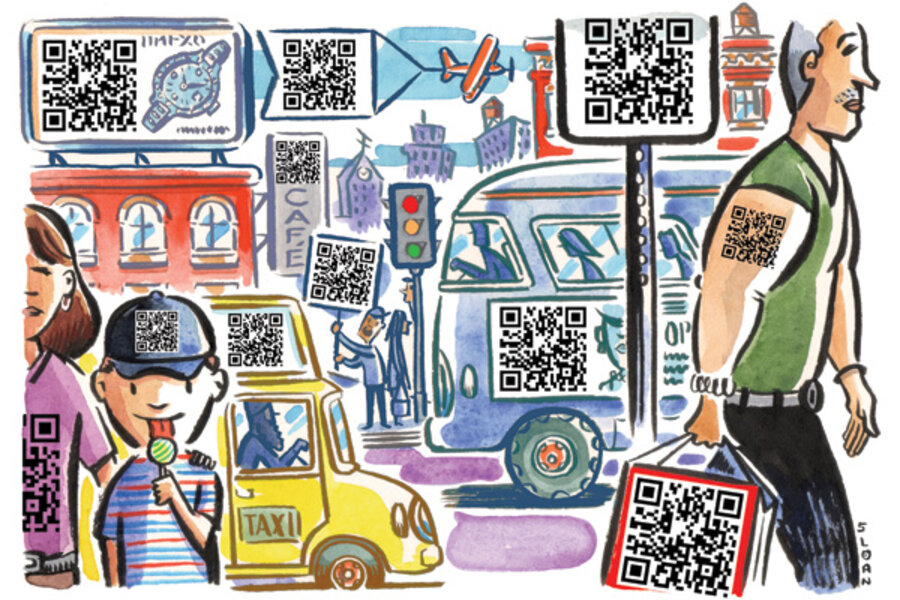QR codes 101: What those squiggles do
Loading...
All of a sudden, Quick Response (QR) codes are everywhere. The checker-patterned squares now come emblazoned on everything from in-store displays at Macy's to bottles of Heinz ketchup. You may have even spotted them in recent issues of this magazine.
Snap a picture of one with your smart phone and the QR code will automatically load a website, cue up a video, or download a coupon right to your device.
Yet despite QR codes' seeming ubiquity, few people know how to use them. The idea sounds simple – scan and enjoy! – but using the technology actually requires a little prep work.
So, with companies experimenting with increasingly frequent and creative uses for QR codes, here's a quick primer on how to use them and why you'd want to.
"Nobody's going to have to go back home and go, 'What was the website I was going to look up earlier? I can't remember,' " says Rick Mathieson, a marketing consultant and author of "The On-Demand Brand." Now you can pull out your phones – the one device that people have on them all the time – and take action immediately."
"QR codes are a notion whose time has come," says Mr. Mathieson, "if only the technology would catch up with the concept."
The problem, he says, revolves around the three QR hurdles. First, you need to have a certain kind of phone. The Apple iPhone, Windows Phone 7 devices, and the numerous Google Android phones all make the cut. BlackBerry, Nokia, and other phones might work, depending on whether they have both a camera and some way to download software, which leads to the second hurdle:
You need to download a QR program onto your phone. Despite the promise of "scan and enjoy," snapping a normal cellphone photo of the black-and-white patterns won't do anything special. The phone must use an application designed to read QR codes. The good news: Each of the devices mentioned above offers multiple, free options. A quick search for "QR" in your respective app store should do the trick.
And third, marketers need to win you over. Even after you download the right software, using a QR code requires you to take out your phone, open the correct app, let your camera focus on the two-tone tiles, snap the picture, wait for the phone to decipher the code, and then enjoy your reward. The process from reaching into your pocket to receiving your prize takes about 20 seconds – not exactly convenient on the go.
Perhaps that's why a study from the digital analysts at comScore found that of the 14 million Americans who used QR codes in June, by far the largest group (58 percent) did so in the comfort of their homes – scanning magazines, newspaper ads, food labels, etc. (Still, comScore estimates that only 6 percent of all smart-phone owners scanned a QR code that month.)
"It will take some effort to convince consumers that this is worth their time," says Noah Elkin, principal analyst at eMarketer in New York.
Some of the best examples, he says, are rolling into retail stores, the second most popular place for QR scans.
Earlier this year, Home Depot introduced a sweeping QR program. Its codes, attached to print ads and products throughout the store, bring up instructional videos and how-to demonstrations.
Of course, since smart phones have their own Web browsers, Home Depot could have simply handed out addresses to the same online information. But QR codes require zero typing and get shoppers to the information faster – at least in theory.
"We know that consumers are doing more in-store shopping than [a few years ago]," says Mr. Elkin, referring to an upcoming study by his firm. Shoppers "want extra information, such as reviews, before pulling out their wallets. But because of smart phones, they no longer need to wait until they get home. They can get much more information while they're in the store."
Movies and video games sneak QR codes into the scenery, giving fans an optional peek behind the curtain. For example, this year's gaming hit Deus Ex: Human Revolution has put the markers on in-game objects. Scanning them with real-world phones leads players to the website for the fictional company behind the game's mystery.
The Christian Science Monitor puts these codes on its print pages to link readers to extra articles, online photo galleries, or videos. (The magazine recently switched from the colorful triangles of Microsoft Tags to the more popular black-and-white QR codes. Several other styles exist, but in most cases, they each require a separate phone app to work.)
"Very few people are actually going to do this this way," Mathieson says, noting that while QR codes have a much broader audience overseas, Americans have been slow to accept them. "But it will start to catch on over time."





